Ælfgif-who? provides short biographies of early medieval English women. Click on the podcast player if you’d like to hear this newsletter read aloud in my appealing Yorkshire accent.

The Trumpington Girl: Buried in her bed
Sometime in the late seventh century, a teenage girl died. She had been in chronic ill health for some time before she passed away, perhaps since early childhood. A high-status member of the community, she was laid to rest in an ornate bed at the bottom of a grave. This grave was dug among three or four other graves at the edge of a small settlement consisting of a few pit-houses, a wooden hall and some wells, situated around an existing Beaker burial mound in what is now Trumpington Meadows, just south of Cambridge. Some of her most precious belongings were placed beside her, including an antler comb, some glass beads, an iron knife, a chatelaine, and two gold garnet-encrusted pins that secured a veil around her head. A beautiful ornate gold and garnet cross, which was sewn to the front of her clothes, expressed her religious beliefs as an early Christian. Laid there in her bed, she must have looked as if she were asleep. Her community said a final goodnight and covered her over with soil. Her grave was unmarked and ultimately forgotten.
The settlement was abandoned and the girl laid undisturbed for over 1300 years before she was discovered once again by archaeologists in 2011 when the cluster of seventh-century graves was excavated. One of the graves, Grave 1, was more elaborate than the others and originally assumed to be the focal point of the group, until radiocarbon dating found this grave to be the newest addition to the cluster. The burial of a person in her bed, one of only a handful of English ‘bed burials’ known to us, indicated by fragments of wood and metal cleats, made the discovery remarkable. But it was perhaps her beautiful cross, known as the Trumpington Cross - one of five such pectoral crosses from this period - that received the most attention.
Everything we know about the Trumpington girl must be gleaned from this single snapshot of her grave site. No written sources identify her. Any biography is bound to be incomplete. However, it is interesting just how much information was uncovered and continues to be uncovered by the archaeologists, scientists and historians who investigated this burial.1
It is a common misconception that it’s easy to determine the sex of historical human remains. Sex can only be estimated, based on a number of factors, with the most reliable (but still indefinite) sign being the size of the pelvis. However, all of the graves at the Trumpington site contained poorly-preserved skeletons due to harsh soil conditions. The skeleton in Grave 1 was missing hand and feet bones and the pelvis was too degraded to estimate the sex. Without a pelvis to measure, isotopic analysis can be used to determine the levels of copper and iron in the bone, which tends to correlate with pelvis size and indicate a probable sex. Analysis of a rib bone revealed that the skeleton in the grave is probably female. A combination of dental and bone analysis revealed a likely age of the person when they died of 14-18 years.
Grave goods provide a more illuminating indication of the gender of the person buried in Grave 1. In the seventh century, although Christian beliefs were taking hold in England, the pre-Christian custom of burying people with grave goods was still practiced. Grave goods can be a good indicator of the social position someone occupied and the type of clothing they were wearing when buried, and they arguably say more about the actual role and lifestyle of the occupant of the grave than a simple pelvic measurement. The grave goods buried with the Trumpington girl, such as the beads, comb, knife, the bejewelled veil pin and chatelaine (a type of utility belt worn around the waist by women) are typical of female graves in this period.
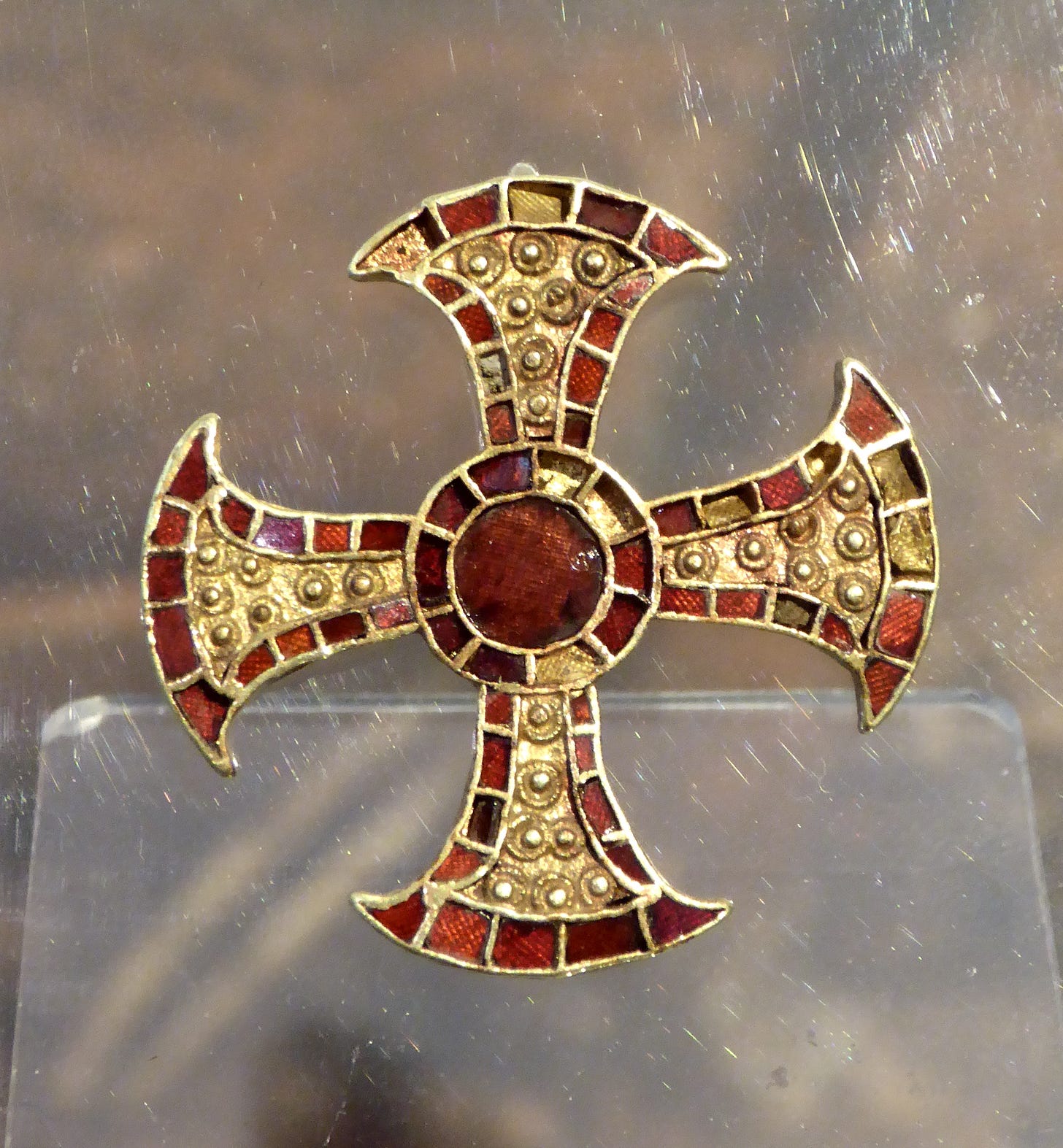
The most remarkable of the grave goods buried with the Trumpington girl is the gold and garnet pectoral cross. This cross serves as the sole indication that the Trumpington girl was an early convert to Christianity. The cross measures just over an inch in diameter, and was designed in the cloisonné style, with individual metal cells holding beautiful garnets. These garnets, which were usually originally from India or Bohemia, would have been brought to England by merchants. The combination of rare, high-value materials and craftsmanship makes the cross a very high-status item. There are five such garnet crosses surviving from seventh-century England, and metal crosses are strongly associated with female burial, with one notable exception being the famous Cuthbert cross buried with Saint Cuthbert.2 Three of these crosses have been found in bed burials, suggesting a strong link between women buried in their beds, early Christianity and this distinct form of jewellery. The presence of such an unusual and high-status indicator of Christianity in the grave of a young girl marks her out as exceptional, though for what exact reason remains unknown.
Probably the most interesting feature of the Trumpington girl's grave is the elaborate carved wooden bed in which she was laid to rest. A handful of such burials exist in England, and again all in the seventh century. The meaning of such a burial is complex - while it could be understood along with the comb and knife as a grave good that may be useful in the afterlife, it could also represent a distinctly Christian belief about death simply being a state of sleep until the resurrection. A study of 72 bed burials across Europe in the early medieval period conducted by Dr Emma Brownlee concluded that the custom of bed burials, relatively rare in England compared to the rest of Europe, may have been introduced specifically by Christian women who migrated to England to marry non-Christians.3 Paying subscribers will remember my newsletter about the role of women in Christian conversion in this period; these marriages could create a space in which Christian and non-Christian beliefs were held and practiced simultaneously in the same context. The Trumpington girl's grave is also representative of this time and space.
There is one other factor to take into account that adds to the context of this burial. As well as revealing her age, dental analysis suggests a childhood illness and iron deficiency, which was possibly caused by a parasite, a disease such as leprosy, or even heavy blood loss. It is not known whether any of these specific factors resulted in her death, but it is apparent that the girl in Grave 1 likely suffered chronic ill health from early childhood. As a disabled and chronically ill person myself, I experience periods of bed-rest and even long periods of being bed-bound. I find myself feeling empathy for the Trumpington girl and wondering whether she spent some of her life, just as her death, in bed.
Beds were extremely high-status items of furniture, and the fragments of wood found of the Trumpington bed indicate the bed in Grave 1 was even decorated with carving. There is mixed evidence as to whether the beds found in graves were constructed especially for the burial of if they were the bed used by the occupant of the grave in their lifetime.4 The narrow size of many of them suggests they were purely built for funerary purposes, while modifications made to some beds indicate they were not built to specifically fit the grave. In the case of Grave 1, the bed has largely decayed, but the positioning of the rivets indicate it was 24 inches wide, two thirds the size of a standard modern single bed. Could the Trumpington girl have rested in this bed while experiencing ill health? Could she have even died in this very bed? Might a bed burial have seemed fitting for those who knew her as bedbound in life? It is all conjecture, but it is certainly possible.
While the circumstances of this inhumation and the archeological techniques used to investigate it are fascinating, it’s useful to remind ourselves of the human that lies at the centre of it. From the archaeological record, we can glean something of what this girl’s life might have been like. She was clearly an important figure, set apart from others in status by the glinting garnet jewellery pinning her veil and sewn to her chest. This chest ornament did not only signify her wealth, but also her religion. It marked her out as a convert. But she was also ailing, and though her cause of death is unknown, her life was cut very short. In death, she was set apart once again by the presence of her cross and the extravagance of her burial in a narrow carved bed.
The majority of the information in this post was gleaned from the archaeological report: Riversides: Neolithic Barrows, a Beaker Grave, Iron Age and Anglo-Saxon Burials and Settlement at Trumpington, Cambridge, by Christopher Evans, Sam Lucy, and Ricky Patten
Sam Lucy, The Trumpington Cross in Context, Anglo-Saxon England, 47
Brownlee (2022)
Further Reading:
University of Cambridge: Mystery of Anglo-Saxon teen buried in her bed with gold cross
University of Cambridge: Trumpington Cross goes on display for the first time
Live Science: Mystery behind medieval Bed Burials in UK possibly solved
Wiley Analytical Science: Sex, bones and isotopes: Determining the sex of human remains with isotopes

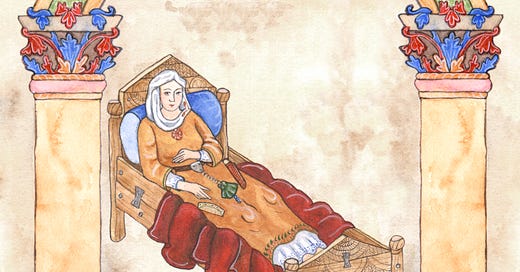



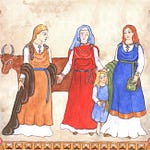

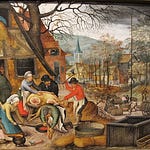




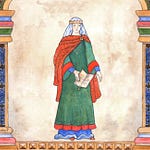
Share this post